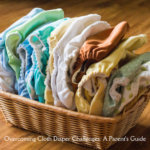Choosing cloth diapers over disposables is a commitment to both your baby’s health and the environment. This guide dives deep into the world of cloth diapering, offering practical advice and personal insights from a father of three, ensuring you have all the information you need to make an informed decision.
Unlocking the Secrets to Effective Cloth Diapering
The Types of Cloth Diapers: A Comprehensive Overview
Cloth diapering has evolved significantly, and understanding the different types available is crucial:
- Flat Diapers: The most traditional form, requiring folding and fastening.
- Prefolds: Similar to flats but with additional absorbent layers sewn in.
- Fitted Diapers: Shaped like disposables, with elastic leg openings and built-in snaps or Velcro.
- Pocket Diapers: Feature a pocket for inserting absorbent pads.
- All-in-Ones (AIOs): The closest to disposable diapers, with no separate parts.
Each type offers unique benefits, from the customizability of flats and prefolds to the convenience of AIOs.
Mastering Cloth Diaper Cleaning: Essential Tips and Tricks
Effective cleaning is paramount to successful cloth diapering:
- Routine Setup: Establish a consistent washing routine to manage diaper hygiene.
- Pre-rinsing: Remove solids and pre-rinse in cold water to prevent stains.
- Washing: Use a gentle, effective detergent in hot water for deep cleaning.
- Drying: Air dry when possible to extend the life of the diapers.
Table: Recommended Cleaning Agents for Different Diaper Types
| Diaper Type | Detergent Type | Wash Frequency |
|---|---|---|
| Flat | Mild | Every 2-3 days |
| Fitted | Mild, Fragrance-free | Every 2 days |
| AIO | Enzyme-free | After every use |
Transition Guide: From Disposable to Cloth
Transitioning to cloth diapers can be daunting, but with the right approach, it becomes manageable:
- Start Gradually: Introduce cloth diapers slowly alongside disposables.
- Choose the Right Type: Begin with easier types like AIOs before exploring others.
- Engage Your Support System: Ensure all caregivers are on board and informed.
Actionable Tips: Real-World Advice from a Dad of Three
Drawing from my personal experience, here are key strategies for incorporating cloth diapers into your daily life:
- Organize a Diaper Station: Have all necessary supplies at hand, including a dedicated bin for soiled diapers.
- Deal with Diaper Rash: Ensure frequent changes and use barrier creams compatible with cloth diapers.
- Stay Committed: Persistence is key. The transition period is challenging but rewarding.
Tackling Common Challenges
No journey is without its obstacles, and here are solutions to some common cloth diapering challenges:
- Leakage Issues: Optimize the fit and consider double layering during nighttime.
- Maintenance Overwhelm: Create a maintenance schedule that fits your lifestyle, possibly integrating tasks like washing and folding into your routine.
Conclusion: Why Cloth Diapering Is Worth It
Cloth diapering is more than just a parenting choice—it’s a lifestyle commitment that benefits the environment and your wallet while providing your baby with comfort and health. As you become more familiar with the different types and maintenance techniques, you’ll find that cloth diapering is not only feasible but also deeply rewarding.







